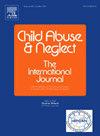暴露于邻里暴力、自我效能和儿童虐待
IF 3.4
2区 心理学
Q1 FAMILY STUDIES
引用次数: 0
摘要
在美国,虐待儿童是一个重大的公共卫生问题,对儿童的发展有着长期的影响。暴露于社区暴力是儿童虐待的已知风险因素,但这种关系背后的机制尚不清楚。自我效能感是一种反映个体影响环境的感知能力的构念,可能在这一途径中发挥重要的中介作用。目的探讨自我效能感是否在社区暴力暴露与儿童虐待(包括身体攻击、心理攻击和忽视)之间起中介作用。参与者和背景数据来自“未来家庭和儿童福利研究”,这是一项对4898名出生在美国20个主要城市的儿童进行的纵向研究。分析的重点是儿童3岁时的第三波数据。方法采用结构方程模型,通过自我效能感这一中介变量,评估社区暴力暴露对三种儿童虐待行为的直接和间接影响。结果社区暴力暴露对产妇自我效能感有直接的负向影响。反过来,更高的自我效能感对所有三种形式的儿童虐待都有保护作用。自我效能在暴露于社区暴力和儿童虐待之间起到部分中介作用,强调了暴露于暴力影响父母行为的途径。结论研究结果强调了自我效能感在减轻社区暴力对儿童虐待的影响中作为一种保护性途径的重要性。旨在提高父母自我效能和减少社区暴力的干预措施可能对预防儿童虐待具有重要意义。本文章由计算机程序翻译,如有差异,请以英文原文为准。
Exposure to neighborhood violence, self-efficacy, and child maltreatment
Background
Child maltreatment is a significant public health concern in the United States, with long-lasting consequences for children’s development. Exposure to community violence is a known risk factor for child maltreatment, yet the mechanisms underlying this relationship are unclear. Self-efficacy, a construct reflecting an individual’s perceived ability to influence their environment, may play a critical mediating role in this pathway.
Objective
This study aimed to investigate whether self-efficacy mediates the relationship between exposure to community violence and child maltreatment, including physical assault, psychological aggression, and neglect.
Participants and setting
Data were drawn from the Future of Families and Child Wellbeing Study, a longitudinal study of 4898 children born in 20 major cities in the United States. The analysis focused on the third wave of data when children were age 3.
Methods
Structural equation modeling was employed to assess the direct and indirect effects of exposure to community violence on three forms of child maltreatment through the mediating variable of self-efficacy.
Results
Exposure to community violence had a direct negative impact on maternal self-efficacy. In turn, higher self-efficacy was protective against all three forms of child maltreatment. Self-efficacy partially mediated the relationship between exposure to community violence and child maltreatment, highlighting a pathway through which exposure to violence affects parenting behaviors.
Conclusions
Findings underscore the importance of self-efficacy as a protective pathway in mitigating the effects of community violence on child maltreatment. Interventions aimed at enhancing parental self-efficacy and reducing community violence may have significant implications for preventing child maltreatment.
求助全文
通过发布文献求助,成功后即可免费获取论文全文。
去求助
来源期刊

Child Abuse & Neglect
Multiple-
CiteScore
7.40
自引率
10.40%
发文量
397
期刊介绍:
Official Publication of the International Society for Prevention of Child Abuse and Neglect. Child Abuse & Neglect The International Journal, provides an international, multidisciplinary forum on all aspects of child abuse and neglect, with special emphasis on prevention and treatment; the scope extends further to all those aspects of life which either favor or hinder child development. While contributions will primarily be from the fields of psychology, psychiatry, social work, medicine, nursing, law enforcement, legislature, education, and anthropology, the Journal encourages the concerned lay individual and child-oriented advocate organizations to contribute.
 求助内容:
求助内容: 应助结果提醒方式:
应助结果提醒方式:


